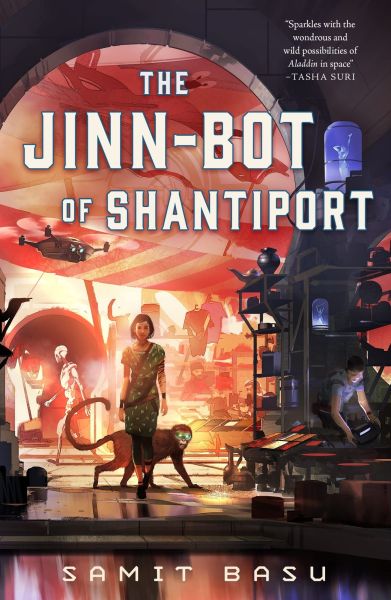Dance Monkey
The Jinn-Bot of Shantiport
By Samit Basu

17 Nov, 2023
0 comments
Samit Basu’s 2023 The Jinn-Bot of Shantiport is a stand-alone science fiction novel.
History grinds on. Once the center of a powerful nation, Shantiport is now a backwater colonial possession on a backwater planet. In theory, the port should be the point of egress from the planet. In practice, the city is a trap from which escape is very difficult.
Lina and Bador’s parents Darkak and Johra opposed the Tiger Clan’s domination of Shantiport. Their efforts got results: Darkak vanished ten years before and has not been seen since, while Johra is closely watched by the Tiger Clan.
Lina is determined to free her city. Bador for his part is tired of being her uninformed errand boy. Moku the storybot documents it all.
Lina’s hesitancy to keep Bador fully informed is driven by the fact that Bador isn’t just her brother. He’s a cyborg monkey whose common sense is as deficient as his exuberance is large. Bador is determined to be a celebrity hero and if that means embracing a succession of extremely risky gambits, so be it.
Lina is drawn into a treasure hunt by charming antagonist Shakun Antim — the man who betrayed Darkak — because her blood is the key to her father’s hidden caches. If Shakun can get his hands on Darkak’s most precious treasure, his lofty social position will be unassailable. This plan has only one tiny flaw: the treasure he seeks could end up in Lina’s hands instead.
The galaxy is filled with civilizations whose sufficiently advanced technology is, at least to the backward people of Shantiport, indistinguishable from magic. The entity in the lamp may not be the jinn of legend but it is functionally identical. Having gained possession of the lamp, Lina gets the obligatory three wishes1.
Lina is far too canny to fall victim to the usual wish pitfalls. Her requests are considered and carefully phrased. Shakun is consigned to ignominious obscurity. Lina and her faction are now ascendant.
What follows is an extended lesson that one can get exactly what one wants and still be unhappy, that even power wielded in the name of the greater good can corrupt, and that stories are never actually over.
~oOo~
Speaking of stories that are never over, this novel went on about a hundred pages longer than I cared to read. There was definite narrative fatigue towards the end of the book. In the real world, events go on and on, but in novels it’s nice to have closure. This book kept offering yet one more sudden twist.
This would be a fine example of a struggle to liberate people in which it turns out that reform does not mean establishing some sort of democratically-selected responsible government, but merely altering which oligarch rules. How exactly the Tiger Clan makes decisions is unclear2, but the new regime is effectively rule by a single family.
To her credit, Lina is bothered by the Meet the New Boss, Same as the Old Boss aspect of the new normal. She could get even more points if she didn’t lean into her new status. Of course, she does. Ah, well.
While the novel may be disappointing from the political reform angle, the author delivers an abundance of fast-paced action sequences. These are greatly facilitated by Bador’s excessive confidence and Shakun’s rapid-fire scheming. There is always at least one more complication than the protagonists planned for. Not all of the characters, of whom there are legions, are fully developed, but the core trio — Lina, Bador, and Moku — are nicely detailed. It’s exuberant science fantasy, a novel people less grumpy than I am will probably enjoy more than I did.
The Jinn-Bot of Shantiport is available here (Amazon US), here (Amazon Canada), here (Amazon UK), here (Apple Books), here (Barnes & Noble), and it might be available here (Chapters-Indigo). I am not sure if that’s actually the book itself or a preview. Odd that it’s missing its cover but that’s part of a pattern concerning books by POC I’ve seen at Chapters.
1: Lina’s three wishes come with the free trial. More wishes require accessing Unlimited Mode.
2: However the Tiger Clan makes decisions, the process is inefficient.
